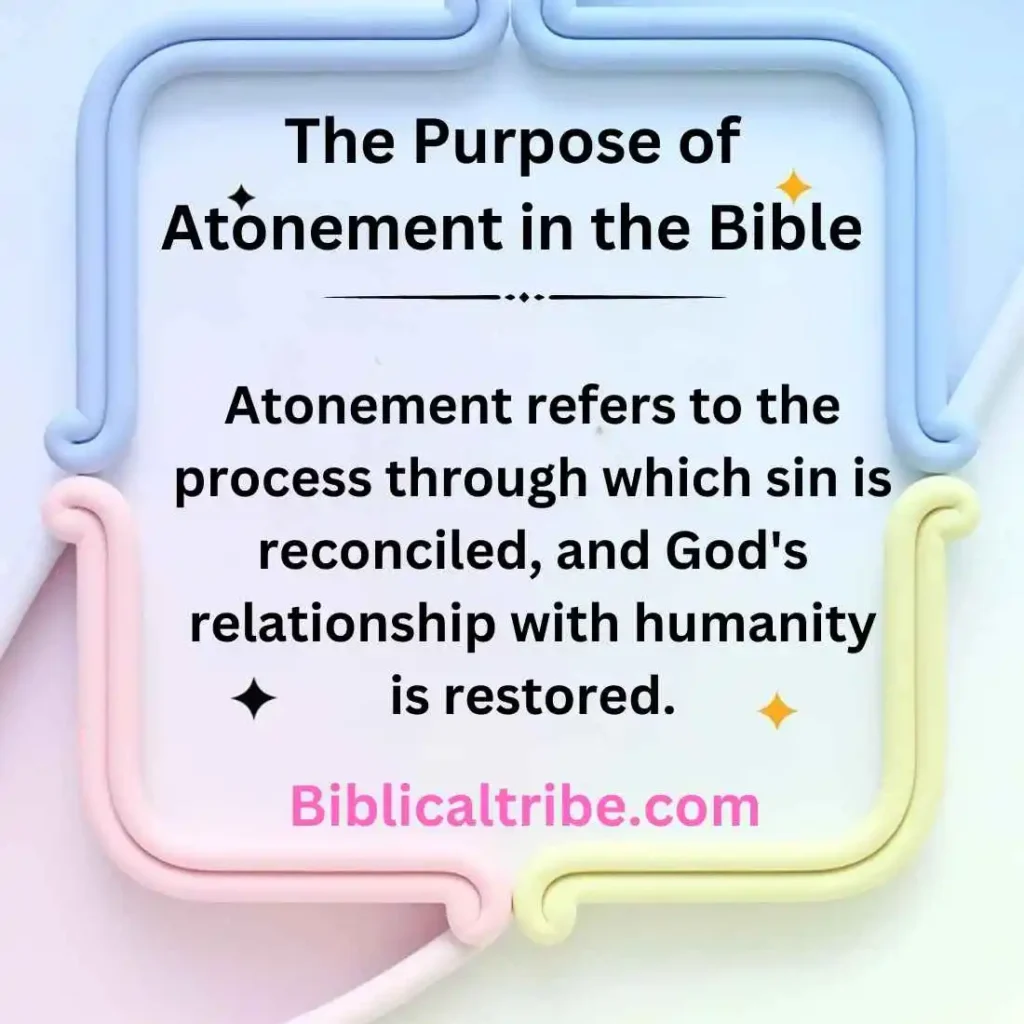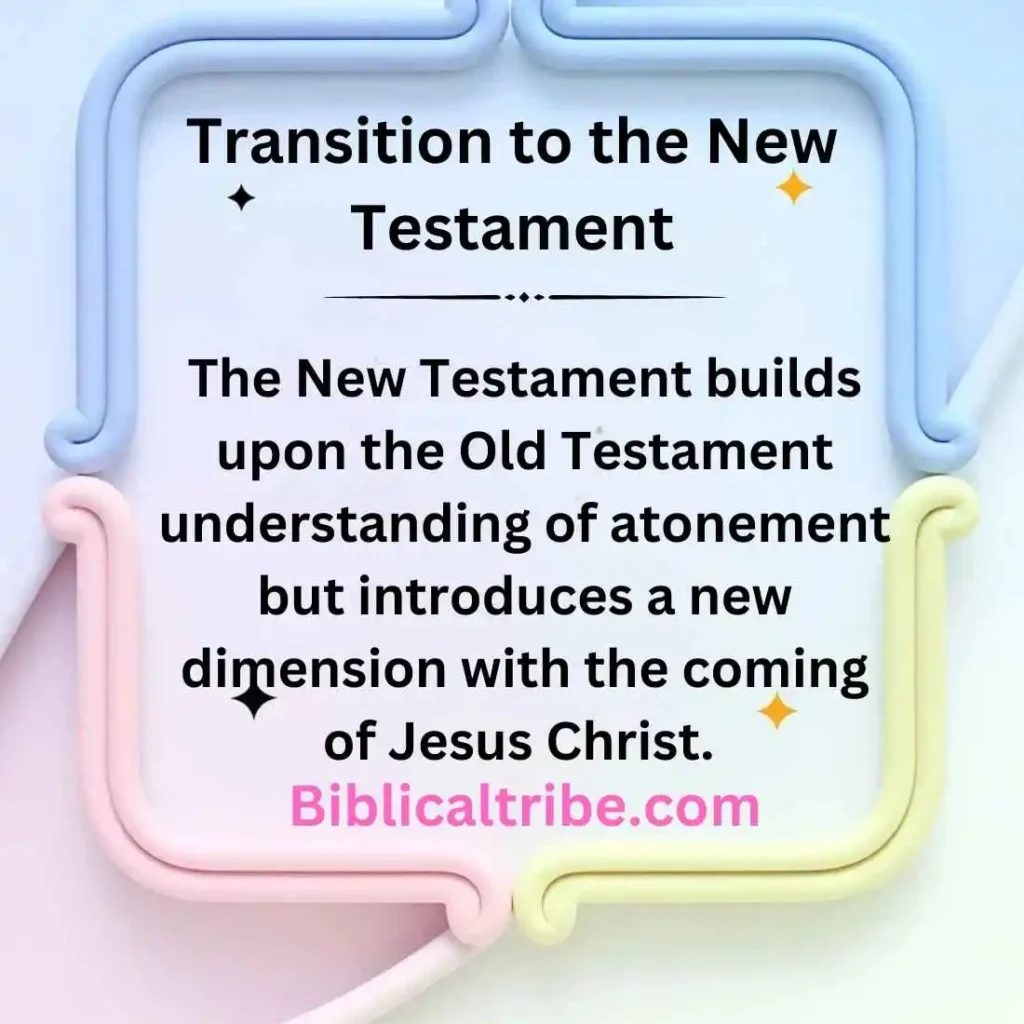Last Updated on November 25, 2024 by Ethan Richards
Atonement is a foundational concept in Christian theology, deeply embedded in both the Old and New Testaments.
This blog post delves into the multifaceted nature of atonement, exploring its historical, theological, and practical aspects.
Discover the profound meaning of atonement in the Bible as we delve into its key concepts and significance. From the sacrificial system of the Old Testament to Christ’s ultimate sacrifice, explore how atonement bridges the gap between humanity and God. Gain deeper insights into forgiveness, reconciliation, and redemption in this enlightening article.
By examining the purpose, theories, and contemporary perspectives on atonement, we aim to provide a thorough understanding of this crucial doctrine.
The Purpose of Atonement in the Bible

Atonement refers to the process through which sin is reconciled, and God’s relationship with humanity is restored.
It is derived from the Hebrew word kippur and the Greek word hilasterion, both of which imply a covering or reconciliation.
Atonement addresses the breach caused by sin and seeks to mend the relationship between God and humanity.
In the Bible, atonement serves several purposes:
- Restoring Relationship: It heals the separation caused by sin, allowing for a renewed relationship between God and His people.
- Reaffirming Justice: Atonement demonstrates God’s justice by addressing the penalty for sin.
- Promoting Reconciliation: It facilitates peace and reconciliation both between individuals and within communities.
The Old Testament View of Atonement
Concept of Sin and Its Consequences
In the Old Testament, sin is depicted as a serious offense against God, leading to separation and judgment. The consequences of sin include guilt, punishment, and a disrupted relationship with God.
For instance, the story of Adam and Eve in Genesis illustrates the entry of sin into the world and its ramifications.
Key Concepts:
- Sin as Transgression: Sin is viewed as a violation of God’s commandments.
- Guilt and Penalty: Sin incurs guilt and requires a penalty, often depicted as death or exclusion from the community.
The Role of Sacrifice in Atonement
Sacrifices played a central role in the Old Testament system of atonement. The sacrificial system provided a means for the Israelites to atone for their sins.
Key sacrifices include:
- Burnt Offerings: Symbolized total devotion to God (Leviticus 1).
- Sin Offerings: Addressed unintentional sins and purified the individual (Leviticus 4).
- Guilt Offerings: Compensated for specific offenses and sought forgiveness (Leviticus 5).
Table: Types of Sacrifices
| Type | Purpose | Key Verses |
| Burnt Offering | Total dedication to God | Leviticus 1 |
| Sin Offering | Atonement for unintentional sins | Leviticus 4 |
| Guilt Offering | Compensation for specific offenses | Leviticus 5 |
The Day of Atonement (Yom Kippur)
The Day of Atonement, or Yom Kippur, is a significant annual event described in Leviticus 16. It involves several key rituals:
- The Scapegoat: A goat is symbolically burdened with the sins of the people and sent into the wilderness, representing the removal of sin.
- The Sin Offering: A bull and a ram are sacrificed to atone for the sins of the high priest and the people.
Quote:
“The Day of Atonement is a pivotal moment for the Israelites, a day when they seek purification and reconciliation with God.” – Leviticus 16:30
Prophetic Perspectives on Atonement
Prophets like Isaiah and Jeremiah began to emphasize a shift from ritualistic atonement to internal repentance.
Isaiah 1:11-17 criticizes empty rituals and calls for genuine repentance and justice, while Jeremiah 7:21-23 highlights the importance of obedience over sacrifice.
Transition to the New Testament

Continuity and Discontinuity with Old Testament Atonement
The New Testament builds upon the Old Testament understanding of atonement but introduces a new dimension with the coming of Jesus Christ.
The key continuities include the need for reconciliation with God and the concept of sacrifice.
However, the discontinuities are significant:
- Fulfillment of Prophecy: Jesus fulfills Old Testament prophecies related to atonement.
- New Covenant: The sacrificial system is replaced by Christ’s sacrifice, marking a new era in atonement theology.
Jesus as the Ultimate Atonement
In the New Testament, Jesus is presented as the ultimate atonement. His death and resurrection are seen as fulfilling and surpassing the Old Testament sacrificial system.
Key passages include:
- Hebrews 9:11-12: Describes Jesus entering the heavenly sanctuary with His own blood to secure eternal redemption.
- 1 John 2:2: States that Jesus is the propitiation for our sins, not only for ours but for the whole world.
Quote:
“By His own blood, He entered the Most Holy Place once for all, having obtained eternal redemption.” – Hebrews 9:12
Theories of Atonement
Christus Victor Theory
The Christus Victor Theory emphasizes Christ’s victory over the powers of sin, death, and the devil.
Originating from early church fathers, this theory sees Christ’s death and resurrection as a cosmic battle won against evil forces.
Key Points:
- Victory over Evil: Christ’s sacrifice is a triumph over spiritual adversaries.
- Scriptural Basis: Passages like Colossians 2:15 highlight Christ’s victory over principalities and powers.
Satisfaction Theory
Satisfaction Theory, developed by Anselm of Canterbury, posits that Christ’s death satisfies the justice of God.
According to this theory, humanity’s sin dishonors God, and Christ’s sacrifice restores the honor due to Him.
Key Points:
- Restoration of Honor: Christ’s sacrifice compensates for the offense against God’s honor.
- Scriptural Basis: The idea is reflected in passages like Romans 3:25-26.
Penal Substitution Theory
Penal Substitution Theory suggests that Christ’s death serves as a substitute for the punishment humanity deserves.
This theory emphasizes that Jesus bore the penalty for sin on behalf of believers, satisfying God’s justice.
Key Points:
- Substitutionary Sacrifice: Christ takes the place of sinners, enduring their punishment.
- Scriptural Basis: Key passages include Isaiah 53:5 and 2 Corinthians 5:21.
Moral Influence Theory
Moral Influence Theory focuses on the transformative effect of Christ’s sacrifice. It argues that Jesus’ death serves as a powerful example, inspiring believers to live lives of love and righteousness.
Key Points:
- Transformative Example: Christ’s sacrifice influences moral and spiritual growth.
- Scriptural Basis: This perspective can be seen in John 15:13, where Jesus speaks of laying down His life for others.
Contemporary Perspectives on Atonement
Atonement and Social Justice
Modern perspectives on atonement often integrate social justice concerns. This view considers how atonement theology can address issues like systemic injustice and oppression.
Contemporary theologians advocate for an understanding of atonement that includes societal transformation and collective salvation.
Case Study:
- Liberation Theology: This approach views atonement as addressing not just individual sin but also social structures that perpetuate inequality.
Feminist and Womanist Approaches
Feminist and Womanist theologians critique traditional atonement theories for their perceived patriarchal and exclusionary elements.
They propose alternative views that emphasize inclusivity, relationality, and gender equality.
Key Points:
- Critique of Traditional Models: Traditional atonement theories are often seen as reinforcing gender hierarchies.
- Alternative Perspectives: Proposals include understanding atonement in terms of healing and relational justice.
Post-Colonial and Liberation Theologies
Post-colonial and liberation theologies explore how atonement relates to issues of colonialism and oppression.
These perspectives focus on how Christ’s sacrifice can be understood as liberating marginalized groups and challenging unjust systems.
Key Points:
- Liberation from Oppression: Atonement as a means of addressing systemic and historical injustices.
- Scriptural Basis: The exodus narrative and prophetic calls for justice are often referenced.
Atonement in Personal Application

Embracing Forgiveness and Transformation
Personal application of atonement involves embracing forgiveness and transformation. Understanding atonement helps individuals to accept God’s forgiveness and extend it to others, fostering personal and relational healing.
Practical Steps:
- Forgiveness: Reflecting on Christ’s sacrifice encourages believers to forgive others.
- Transformation: Embracing the new life offered through atonement leads to personal growth and renewal.
Living Out Atonement in Daily Life
Believers are called to live out the principles of atonement by embodying forgiveness, reconciliation, and justice in their daily lives.
This includes acts of kindness, social advocacy, and personal integrity.
Examples:
- Acts of Reconciliation: Engaging in efforts to mend broken relationships and promote peace.
- Social Justice Initiatives: Participating in efforts to address systemic issues and support marginalized communities.
FAQs
1. What Is Biblical Atonement?
Biblical atonement refers to the reconciliation between humanity and God through the removal or covering of sin. It is a central concept in Christian theology, emphasizing the work of Jesus Christ as a means of restoring the broken relationship between God and people.
2. Why Is Atonement Important in Christianity?
Atonement is vital because it addresses the problem of sin and its consequences. It highlights God’s justice and mercy, offering believers a path to salvation and eternal life. Without atonement, the relationship between God and humanity would remain estranged.
3. What Are the Different Views of Atonement?
Christian theology outlines several key theories of atonement, including:
- Substitutionary Atonement: Christ died as a substitute for sinners.
- Moral Influence Theory: Christ’s sacrifice inspires moral improvement.
- Ransom Theory: Christ’s death paid the ransom to free humanity from sin and Satan.
Each theory offers unique insights into the redemptive work of Christ.
4. How Does the Old Testament Discuss Atonement?
In the Old Testament, atonement is closely tied to sacrifices and rituals, such as the Day of Atonement (Yom Kippur). These practices involved animal sacrifices as a symbolic way of covering sins and reconciling with God. They foreshadowed the ultimate atonement achieved by Jesus Christ in the New Testament.
5. How Does Jesus Fulfill the Concept of Atonement?
The New Testament teaches that Jesus Christ fulfills atonement by serving as the ultimate sacrifice for sin. His death on the cross and subsequent resurrection provide a perfect and eternal solution for humanity’s sin, replacing the temporary measures of the Old Testament.
Conclusion
Atonement is a profound and multifaceted concept in the Bible, integral to understanding Christian theology and practice.
By examining its Old Testament roots, New Testament fulfillment, various atonement theories, and contemporary perspectives, we gain a richer appreciation of its significance.
Embracing the principles of atonement can lead to transformative personal and societal change, offering a path to reconciliation, justice, and renewal.

Ethan Richards is an accomplished author and dream interpreter known for his insightful and thought-provoking analyses. With a keen eye for detail and a passion for biblical studies, Ethan helps readers unlock the secrets of their dreams, offering clarity and spiritual enlightenment.










